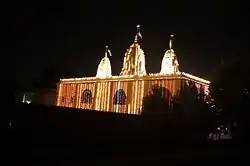Shri Swaminarayan Mandir, Chicago (Itasca)
Shree Swaminarayan Temple, Chicago, IL is a Swaminarayan Hindu temple located in the Chicago suburb of Itasca.[1] Opened in 1998, it comes under ISSO of the Nar Narayan Dev Gadi (Swaminarayan Sampraday).[2] It was built at the cost of $10 million, reportedly the most expensive Hindu temple in the Midwest at that time.[3]
| Shri Swaminarayan Temple | |
|---|---|
 The temple lit up during 10th anniversary celebrations (2008) | |
| Religion | |
| Affiliation | Hinduism |
| Deity | Radha Krishna with Swaminarayan in the form of Hari Krishna |
| Location | |
| Location | Chicago |
| State | Illinois |
| Country | United States |
| Architecture | |
| Completed | 2 August 1998 |
History
Acharya Maharajshree Tejendraprasad Pande inaugurated the temple on 2 August 1998. It is the first Shikharband Swaminarayan temple in the USA. The temple boasts of marriage and banquet facilities and is 34,000 square feet (3,200 m2) in size. The temple claims to have devotees from Islam, Christianity and Buddhism apart from Hindus.[1][4]
10th Anniversary
The temple celebrated its 10th anniversary in 2008 with carnival games and raffles, Indian craft exhibits, henna temporary tattoos, historical exhibits, guided tours of the temple, live dance performances and native foods. Indian culture was the focal point of the nine-day celebrations. The celebration culminated with a mile long procession with 3 floats attended by people from different parts of the United States, India and England. Of the three floats, the first had children in a cultural representation, the second had pictorial representation of Swaminarayan, with a bejeweled umbrella on the top of the float and the last one had Acharya Maharajshree Koshalendraprasad Pande, the current acharya of the Nar Narayan Dev Gadi who attended the festivities and ascetics. During the two-hour procession, women in swirling jewel-toned saris danced to a rhythmic beat on traditional drums. Eleven different cultural performances were organized by temple youth as part of the procession. Officials expected 5000 people to take part in this celebration.[5][6]
Notes
- Holt, Douglas (6 November 1998), HINDU SECT ENRICHES COMMUNITY OF ITASCA NEW TEMPLE PART OF GROWING PRESENCE, Chicago Tribune, retrieved 9 June 2009
- Williams 2004, p. 138
- Anniversary Celebrations at Swaminarayan Temple In Midwest, Rediff.com, 23 June 1999, retrieved 9 June 2009
- About Midwest Swaminarayan Mandir
- Temple to celebrate 10th anniversary, Daily Herald, 25 July 2008, retrieved 9 June 2009
- Thousands gather for Itasca temple's anniversary, Daily Herald, 3 August 2008, retrieved 9 June 2009
References
- Williams, Raymond (2004), Williams on South Asian Religions and Immigration: Collected Works, Ashgate Publishing Ltd., ISBN 0-7546-3856-1
